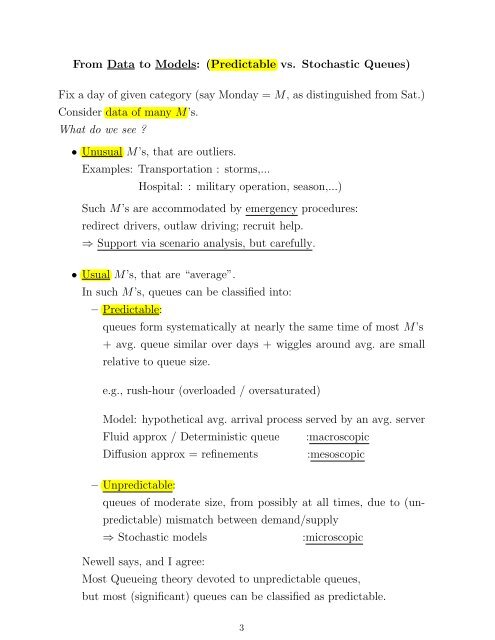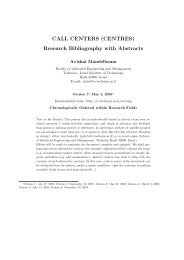PDF-6.4MB - Faculty of Industrial Engineering and Management
PDF-6.4MB - Faculty of Industrial Engineering and Management
PDF-6.4MB - Faculty of Industrial Engineering and Management
Create successful ePaper yourself
Turn your PDF publications into a flip-book with our unique Google optimized e-Paper software.
From Data to Models: (Predictable vs. Stochastic Queues)<br />
Fix a day <strong>of</strong> given category (say Monday = M, as distinguished from Sat.)<br />
Consider data <strong>of</strong> many M’s.<br />
What do we see ?<br />
• Unusual M’s, that are outliers.<br />
Examples: Transportation : storms,...<br />
Hospital: : military operation, season,...)<br />
Such M’s are accommodated by emergency procedures:<br />
redirect drivers, outlaw driving; recruit help.<br />
⇒ Support via scenario analysis, but carefully.<br />
• Usual M’s, that are “average”.<br />
In such M’s, queues can be classified into:<br />
– Predictable:<br />
queues form systematically at nearly the same time <strong>of</strong> most M’s<br />
+ avg. queue similar over days + wiggles around avg. are small<br />
relative to queue size.<br />
e.g., rush-hour (overloaded / oversaturated)<br />
Model: hypothetical avg. arrival process served by an avg. server<br />
Fluid approx / Deterministic queue :macroscopic<br />
Diffusion approx = refinements :mesoscopic<br />
– Unpredictable:<br />
queues <strong>of</strong> moderate size, from possibly at all times, due to (un-<br />
predictable) mismatch between dem<strong>and</strong>/supply<br />
⇒ Stochastic models :microscopic<br />
Newell says, <strong>and</strong> I agree:<br />
Most Queueing theory devoted to unpredictable queues,<br />
but most (significant) queues can be classified as predictable.<br />
3
















